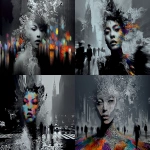Explore the Best AI Image Gallery

Beyond the Brush: How Edge Computing Is Redefining Creative Expression
The intersection of art and technology has always been a fertile ground for innovation. From the first brushstrokes on cave walls to the digital canvases of today, humans have constantly sought new ways to express themselves creatively. Now, with the emergence of edge computing, this artistic evolution is taking an exciting leap forward.
Edge computing, which processes data closer to its source rather than relying solely on centralized cloud servers, is poised to revolutionize the creative industries in profound ways. By enabling real-time data processing, decentralized collaboration, and immersive experiences, its empowering artists, designers, and innovators to push the boundaries of whats possible.
A Canvas for Real-Time Interaction
Imagine a sculptor able to instantly see how changes in material density affect the final form, or a musician whose performance directly influences the visuals projected onto a stage. Edge computing allows for this kind of real-time interaction and feedback, transforming the creative process from a linear journey into a dynamic, collaborative experience.
Decentralized Collaboration: Breaking Down Barriers
Traditionally, creative projects often faced logistical challenges due to geographical distances or the need for centralized file sharing. Edge computing breaks down these barriers by enabling decentralized collaboration, where teams can work together seamlessly regardless of their location. Imagine a group of artists collaborating on a virtual sculpture, each contributing from their own studio and instantly seeing the impact of their changes in real-time.
Immersive Experiences: Blurring Reality and Imagination
Edge computing is also paving the way for immersive creative experiences that blur the lines between reality and imagination. Augmented reality (AR) and virtual reality (VR) applications can leverage edge processing to create hyperrealistic environments, interactive narratives, and personalized user experiences. Think of a museum exhibit where visitors can interact with historical artifacts through AR overlays, or a VR installation that transports them into a surreal dreamscape.
Ethical Considerations: Navigating New Frontiers
While the potential of edge computing in creative industries is immense, its crucial to consider the ethical implications. Issues such as data privacy, algorithmic bias, and the ownership of creative outputs need careful attention. Its essential to develop guidelines and frameworks that ensure responsible and equitable use of this powerful technology.
The Future of Creativity: A Decentralized Canvas
Edge computing is poised to reshape the creative landscape, empowering artists with new tools and possibilities. As data processing becomes more decentralized and real-time interactions become commonplace, we can expect to see a surge in innovative projects that blur the lines between physical and digital realms. The canvas of creativity will expand beyond traditional boundaries, becoming a dynamic, collaborative, and ever-evolving space.


](https://images.ai-img.art/thumbnails/150/a3ed6513a6661aa3ee46e0c2924d1e8888854e91d8908de39db5590dc41f8d8f.webp)



](https://images.ai-img.art/thumbnails/150/0ba0be922ab76af53f75ab90126ae2b18a600ee3b96941e8ab897a9f10594e5a.webp)



















](https://images.ai-img.art/thumbnails/150/bd056a4718c27444e064198762f8dc8ffa1f74f1afd7dcda8d5cb8b142797d6e.webp)



](https://images.ai-img.art/thumbnails/150/ff09e32d2be011c0dd785984c5c1e47839ce551a31da1bde242860b30df2aa30.webp)
